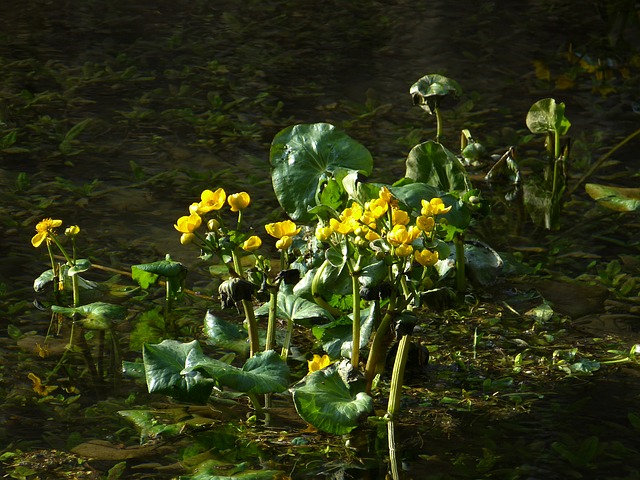 |  |  |   |  |
 |  |
Marsh-marigold is a perennial plant that grows to a height of 25-30 cm. Stems erect or creeping, fully branched, root short. Marsh-marigold , which live in water, can grow with stems up to 3m. The vegetation of the plant begins in early spring. The lower leaves are heart-shaped, located on leaf stems and are large in size, the upper ones are sessile, kidney-shaped. The edges of the leaves are pointedly gritty, veins are clearly visible on the underside of the leaf. Underwater leaves are dark red or purple, above water leaves are green. Under the influence of strong sunlight, the above-water leaves tend to curl.
Marsh-marigold flowers are bright yellow, shiny, up to 6 cm in diameter. It is interesting to mention that the plant begins to bloom only when it reaches 10 years of age. About 7 flowers are placed on long peduncles of Marsh-marigold , which grow from the upper leaf axils. The flower consists of five petals. The first flowers open already in April and their flowering period lasts until the middle of May. Thanks to the bright color of the flower, the plant is able to concentrate the sun's rays to the center, thus raising the temperature. This, accordingly, increases the possibility of attracting insect pollinators.
The fruit of the Marsh-marigold is a follicle. One follicle can contain up to 10, black and shiny seeds (<2.5mm). In late May, early June, the seeds ripen and fall out. The plant also reproduces vegetatively. After the seeds ripen, the lower leaves of the plant do not die and help it store nutrients for the next year.
Marsh-marigold buds are collected in early spring (March), during the season of new leaves. The surface part of the plant, the upper leaves, is collected during the flowering period of the plant (starting from April to the end of May). The plant is dried in well-ventilated rooms or in special dryers, not exceeding a temperature of 50C.
The rhizomes are dug in early spring or autumn, cleaned of soil and dried as mentioned above. Marsh-marigold drug is stored for up to 2 years.
The chemical composition of the Marsh-marigold is still being studied, but the components in it that have already been found confirm the usefulness of this plant for humans. The plant contains flavone compounds, quercetin, carotene (<5.2mg%), choline, anemonin, xanthophyll, ascorbic acid (37mg%), bereberine, bitter substances, saponins, linoleic acid, fatty acids, alkaloids, tannins (<8.1%). The leaves and stems are poisonous when fresh, but become safe after heat treatment.
Medicinal significance
The active substances of Marsh-marigold are saponins, anemonin, flavonoids, choline, as well as carotene and xanthophyll in the flowers. Thanks to the saponins, the plant has great prospects in medicine, but it has its limitations, as the surface part of the plant is poisonous. Protoanemin - a poisonous substance that decomposes during heat treatment of the plant - it turns into anemonin. And it turns into inactive anemonic acid. Thanks to saponins, the plant dissolves sputum and promotes its exit from the bronchi, increases the synthesis of corticosteroids, regulates the metabolism of water salts, and activates the action of hormones. Saponins also prevent the development of cancer cells.
Flavonoids, on the other hand, increase the strength of fine blood vessels, regulate blood pressure, normalize blood rhythm, and also stimulate the function of the cortex of the adrenal glands.
The healing properties of Marsh-marigold have been known for a long time. It has diuretic, anti-inflammatory, pain-relieving, anticonvulsant properties. In folk medicine, alcohol or water infusions of this plant are used to treat liver and gall bladder diseases.
A strong antitussive can be made by combining Marsh-marigold with common sedum and common sedum, usually water-based (decoction).
Commonly, Marsh-marigold is used to treat cough, bronchitis, edema, scrofula and rheumatism. It relieves menstrual pain, treats urinary tract diseases, besides, it has a calming effect, which is useful in cases of nervousness.
Marsh-marigold is an antiseptic. Which can be used for inflammation, burns and wounds as it has wound healing and antimicrobial properties. Marsh-marigold leaves are scalded and wrapped in a gauze pack, then applied as compresses on skin lesions. The decoction can be used to rinse wounds.
Marsh-marigold also has a high content of vitamin C, which can be used to treat scurvy. Medicinal preparations of this plant have a beneficial effect on the growth of nail plates and also help to get rid of nail fungus. Fresh leaf juice can get rid of skin warts.
Marsh-marigold also has weak anticancer properties.
However, Marsh-marigold contains toxic compounds, so it is always used in small doses.
